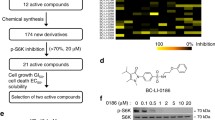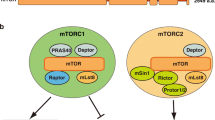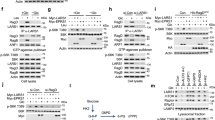Abstract
Among amino acids, leucine is a potential signaling molecule to regulate cell growth and metabolism by activating mechanistic target of rapamycin complex 1 (mTORC1). To reveal the critical structures of leucine molecule to activate mTORC1, we examined the structure–activity relationships of leucine derivatives in HeLa S3 cells for cellular uptake and for the induction of phosphorylation of p70 ribosomal S6 kinase 1 (p70S6K), a downstream effector of mTORC1. The activation of mTORC1 by leucine and its derivatives was the consequence of two successive events: the cellular uptake by l-type amino acid transporter 1 (LAT1) responsible for leucine uptake in HeLa S3 cells and the activation of mTORC1 following the transport. The structural requirement for the recognition by LAT1 was to have carbonyl oxygen, alkoxy oxygen of carboxyl group, amino group and hydrophobic side chain. In contrast, the requirement for mTORC1 activation was more rigorous. It additionally required fixed distance between carbonyl oxygen and alkoxy oxygen of carboxyl group, and amino group positioned at α-carbon. l-Configuration in chirality and appropriate length of side chain with a terminal isopropyl group were also important. This confirmed that LAT1 itself is not a leucine sensor. Some specialized leucine sensing mechanism with rigorous requirement for agonistic structures should exist inside the cells because leucine derivatives not transported by LAT1 did not activate mTORC1. Because LAT1–mTOR axis is involved in the regulation of cell growth and cancer progression, the results from this study may provide a new insight into therapeutics targeting both LAT1 and leucine sensor.







Similar content being viewed by others
References
Bar-Peled L, Schweitzer LD, Zoncu R, Sabatini DM (2012) Ragulator is a GEF for the rag GTPases that signal amino acid levels to mTORC1. Cell 150(6):1196–1208
Beugnet A, Tee AR, Taylor PM, Proud CG (2003) Regulation of targets of mTOR (mammalian target of rapamycin) signalling by intracellular amino acid availability. Biochem J 372(Pt 2):555–566
Bröer S (2008) Amino acid transport across mammalian intestinal and renal epithelia. Physiol Rev 88(1):249–286
Brown EJ, Albers MW, Shin TB et al (1994) A mammalian protein targeted by G1-arresting rapamycin-receptor complex. Nature 369(6483):756–758
Brown EJ, Beal PA, Keith CT et al (1995) Control of p70 s6 kinase by kinase activity of FRAP in vivo. Nature 377(6548):441–446
Brunn GJ, Hudson CC, Sekulic A et al (1997) Phosphorylation of the translational repressor PHAS-I by the mammalian target of rapamycin. Science 277(5322):99–101
Christensen HN (1990) Role of amino acid transport and countertransport in nutrition and metabolism. Physiol Rev 70(1):43–77
Corradetti MN, Guan KL (2006) Upstream of the mammalian target of rapamycin: do all roads pass through mTOR? Oncogene 25(48):6347–6360
Cusack S, Yaremchuk A, Tukalo M (2000) The 2 Angstrom crystal structure of leucyl-tRNA synthetase and its complex with a leucyl-adenylate analogue. EMBO J 19(10):2351–2361
Dann SG, Thomas G (2006) The amino acid sensitive TOR pathway from yeast to mammals. FEBS Lett 580(12):2821–2829
Fort J, de la Ballina LR, Burghardt HE et al (2007) The structure of human 4F2hc ectodomain provides a model for homodimerization and electrostatic interaction with plasma membrane. J Biol Chem 282(43):31444–31452
Fuchs BC, Bode BP (2005) Amino acid transporters ASCT2 and LAT1 in cancer: partners in crime? Semin Cancer Biol 15(4):254–266
Gao X, Zhou L, Jiao X et al (2010) Mechanism of substrate recognition and transport by an amino acid antiporter. Nature 463(7282):828–832
Geier EG, Schlessinger A, Fan H et al (2013) Structure-based ligand discovery for the large-neutral amino acid transporter 1, LAT-1. Proc Natl Acad Sci USA 110(14):5480–5485
Gulati P, Thomas G (2007) Nutrient sensing in the mTOR/S6K1 signalling pathway. Biochem Soc Trans 35(Pt 2):236–238
Han JM, Jeong SJ, Park MC et al (2012) Leucyl-tRNA synthetase is an intracellular leucine sensor for the mTORC1-signaling pathway. Cell 149(2):410–424
Iijima Y, Laser M, Shiraishi H et al (2002) c-Raf/MEK/ERK pathway controls protein kinase C-mediated p70S6K activation in adult cardiac muscle cells. J Biol Chem 277(25):23065–23075
Jewell JL, Guan KL (2013) Nutrient signaling to mTOR and cell growth. Trends Biochem Sci 38(5):233–242
Jewell JL, Russell RC, Guan KL (2013) Amino acid signalling upstream of mTOR. Nat Rev Mol Cell Biol 14(3):133–139
Kaira K, Oriuchi N, Imai H et al (2009) L-type amino acid transporter 1 (LAT1) is frequently expressed in thymic carcinomas but is absent in thymomas. J Surg Oncol 99(7):433–438
Kaira K, Sunose Y, Arakawa K et al (2012) Prognostic significance of L-type amino-acid transporter 1 expression in surgically resected pancreatic cancer. Br J Cancer 107(4):632–638
Kanai Y, Segawa H, Miyamoto K et al (1998) Expression cloning and characterization of a transporter for large neutral amino acids activated by the heavy chain of 4F2 antigen (CD98). J Biol Chem 273(37):23629–23632
Kanazawa T, Taneike I, Akaishi R et al (2004) Amino acids and insulin control autophagic proteolysis through different signaling pathways in relation to mTOR in isolated rat hepatocytes. J Biol Chem 279(9):8452–8459
Khunweeraphong N, Nagamori S, Wiriyasermkul P et al (2012) Establishment of stable cell lines with high expression of heterodimers of human 4F2hc and human amino acid transporter LAT1 or LAT2 and delineation of their differential interaction with alpha-alkyl moieties. J Pharmacol Sci 119(4):368–380
Kim DK, Kanai Y, Choi HW et al (2002) Characterization of the system L amino acid transporter in T24 human bladder carcinoma cells. Biochim Biophys Acta 1565(1):112–121
Kim E, Goraksha-Hicks P, Li L et al (2008) Regulation of TORC1 by Rag GTPases in nutrient response. Nat Cell Biol 10(8):935–945
Kuma A, Hatano M, Matsui M et al (2004) The role of autophagy during the early neonatal starvation period. Nature 432(7020):1032–1036
Lehman JA, Gomez-Cambronero J (2002) Molecular crosstalk between p70S6K and MAPK cell signaling pathways. Biochem Biophys Res Commun 293(1):463–469
Li F, Yin Y, Tan B et al (2011) Leucine nutrition in animals and humans: mTOR signaling and beyond. Amino Acids 41(5):1185–1193
Lincecum TL Jr, Tukalo M, Yaremchuk A et al (2003) Structural and mechanistic basis of pre- and posttransfer editing by leucyl-tRNA synthetase. Mol Cell 11(4):951–963
Lynch CJ, Fox HL, Vary TC et al (2000) Regulation of amino acid-sensitive TOR signaling by leucine analogues in adipocytes. J Cell Biochem 77(2):234–251
Morimoto E, Kanai Y, Kim DK et al (2008) Establishment and characterization of mammalian cell lines stably expressing human L-type amino acid transporters. J Pharmacol Sci 108(4):505–516
Mortimore GE, Poso AR (1987) Intracellular protein catabolism and its control during nutrient deprivation and supply. Annu Rev Nutr 7:539–564
Nicklin P, Bergman P, Zhang B et al (2009) Bidirectional transport of amino acids regulates mTOR and autophagy. Cell 136(3):521–534
Sabatini DM (2006) mTOR and cancer: insights into a complex relationship. Nat Rev Cancer 6(9):729–734
Sabatini DM, Erdjument-Bromage H, Lui M et al (1994) RAFT1: a mammalian protein that binds to FKBP12 in a rapamycin-dependent fashion and is homologous to yeast TORs. Cell 78(1):35–43
Sancak Y, Peterson TR, Shaul YD, Lindquist RA et al (2008) The Rag GTPases bind raptor and mediate amino acid signaling to mTORC1. Science 320(5882):1496–1501
Sancak Y, Bar-Peled L, Zoncu R et al (2010) Ragulator-Rag complex targets mTORC1 to the lysosomal surface and is necessary for its activation by amino acids. Cell 141(2):290–303
Shigemitsu K, Tsujishita Y, Miyake H et al (1999) Structural requirement of leucine for activation of p70 S6 kinase. FEBS Lett 447(2–3):303–306
Sinclair LV, Rolf J, Emslie E et al (2013) Control of amino acid-transport by antigen receptors coordinates the metabolic reprogramming essential for T cell differentiation. Nat Immunol 14(5):500–508
Stipanuk MH (2007) Leucine and protein synthesis: mTOR and beyond. Nutr Rev 65(3):122–129
Su TZ, Feng MR, Weber ML (2005) Mediation of highly concentrative uptake of pregabalin by L-type amino acid transport in Chinese hamster ovary and Caco-2 cells. J Pharmacol Exp Ther 313(3):1406–1415
Uchino H, Kanai Y, Kim DK et al (2002) Transport of amino acid-related compounds mediated by L-type amino acid transporter 1 (LAT1): insights into the mechanisms of substrate recognition. Mol Pharmacol 61(4):729–737
van Bree JB, Audus KL, Borchardt RT (1988) Carrier-mediated transport of baclofen across monolayers of bovine brain endothelial cells in primary culture. Pharm Res 5(6):369–371
Wiriyasermkul P, Nagamori S, Tominaga H et al (2012) Transport of 3-fluoro-l-alpha-methyl-tyrosine by tumor-upregulated L-type amino acid transporter 1: a cause of the tumor uptake in PET. J Nucl Med 53(8):1253–1261
Wu G (2009) Amino acids: metabolism, functions, and nutrition. Amino Acids 37(1):1–17
Wullschleger S, Loewith R, Hall MN (2006) TOR signaling in growth and metabolism. Cell 124(3):471–484
Xu G, Kwon G, Marshall CA et al (1998) Branched-chain amino acids are essential in the regulation of PHAS-I and p70 S6 kinase by pancreatic beta-cells. A possible role in protein translation and mitogenic signaling. J Biol Chem 273(43):28178–28184
Yamashita A, Singh SK, Kawate T et al (2005) Crystal structure of a bacterial homologue of Na+/Cl− dependent neurotransmitter transporters. Nature 437(7056):215–223
Yamauchi K, Sakurai H, Kimura T et al (2009) System L amino acid transporter inhibitor enhances anti-tumor activity of cisplatin in a head and neck squamous cell carcinoma cell line. Cancer Lett 276(1):95–101
Yanagida O, Kanai Y, Chairoungdua A et al (2001) Human L-type amino acid transporter 1 (LAT1): characterization of function and expression in tumor cell lines. Biochim Biophys Acta 1514(2):291–302
Zoncu R, Efeyan A, Sabatini DM (2011) mTOR: from growth signal integration to cancer, diabetes and ageing. Nat Rev Mol Cell Biol 12(1):21–35
Acknowledgments
The authors would like to thank Yasuhiro M. Umemura for his valuable advice and Yoko Tanaka for her technical assistance. This work was supported in part by Grant-in-Aid for Scientific Research and Grant-in-Aid for Young Scientists from Japan Society for the Promotion of Science (JSPS), by Regional Innovation Strategy Support Program, Grant-in-Aid for the Scientific Research on Innovative Areas “HD Physiology”, and Grant-in-Aid for Scientific Research on Priority Areas “Transportsome” from Ministry of Education, Culture, Sports, Science and Technology of Japan (MEXT), and by grants from the Osaka Medical Research Foundation for Intractable Diseases, the Advanced Research for Medical Products Mining Program of the National Institute of Biomedical Innovation, and the Ajinomoto Amino Acid Research Program.
Author information
Authors and Affiliations
Corresponding author
Ethics declarations
Conflict of interest
The authors declare no conflict of interest.
Additional information
Handling Editor: E. I. Closs.
S. Nagamori and P. Wiriyasermkul contributed equally to this work.
Electronic supplementary material
Below is the link to the electronic supplementary material.
Rights and permissions
About this article
Cite this article
Nagamori, S., Wiriyasermkul, P., Okuda, S. et al. Structure–activity relations of leucine derivatives reveal critical moieties for cellular uptake and activation of mTORC1-mediated signaling. Amino Acids 48, 1045–1058 (2016). https://doi.org/10.1007/s00726-015-2158-z
Received:
Accepted:
Published:
Issue Date:
DOI: https://doi.org/10.1007/s00726-015-2158-z




